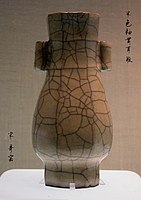Five Great Kilns

The Five Great Kilns (Chinese: 五大名窯; pinyin: Wu da ming yao), also known as Five Famous Kilns, is a generic term for ceramic kilns or wares (in Chinese 窯 yao can mean either) which produced Chinese ceramics during the Song dynasty (960–1279) that were later held in particularly high esteem. The group were only so called by much later writers, and of the five, only two (Ru and Guan) seem to have produced wares directly ordered by the Imperial court, though all can be of very high quality. All were imitated later, often with considerable success.[1]
All except Ding ware made celadon, and in Western terms the celadon kilns are stoneware, rather than the Ding early porcelain. The celadons placed great emphasis on elegant forms, and their ceramic glazes, and were otherwise lightly decorated, with no painting.
The five kilns produced respectively:
History of the term
Although the group and name is generally said in books to have been a coinage by Chinese writers from the Ming or Qing dynasties, a recent paper analysing the main Chinese scholars suggests the modern number and selection of "great kilns", as given here, in fact only dates back to the mid-20th century, with various numbers and other kilns often found in previous writers. In particular, the semi-mythical Chai ware, and Longquan celadon often feature in earlier groupings, and Jun ware is often omitted.[2]
-
Ru ware bowl, with metal rim, 1086-1125
-
Small Guan ware bowl on legs (some 3 inches across), with pronounced glaze crackle, Southern Song
-
Ding ware dish with garden landscape, "molded stoneware with impressed decoration, transparent glaze, and banded metal rim", 13th century, diameter 5.5 in. (14 cm)
Notes
References
- Rawson, Jessica (ed). The British Museum Book of Chinese Art, 2007 (2nd edn), British Museum Press, ISBN 9780714124469





